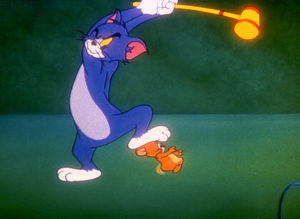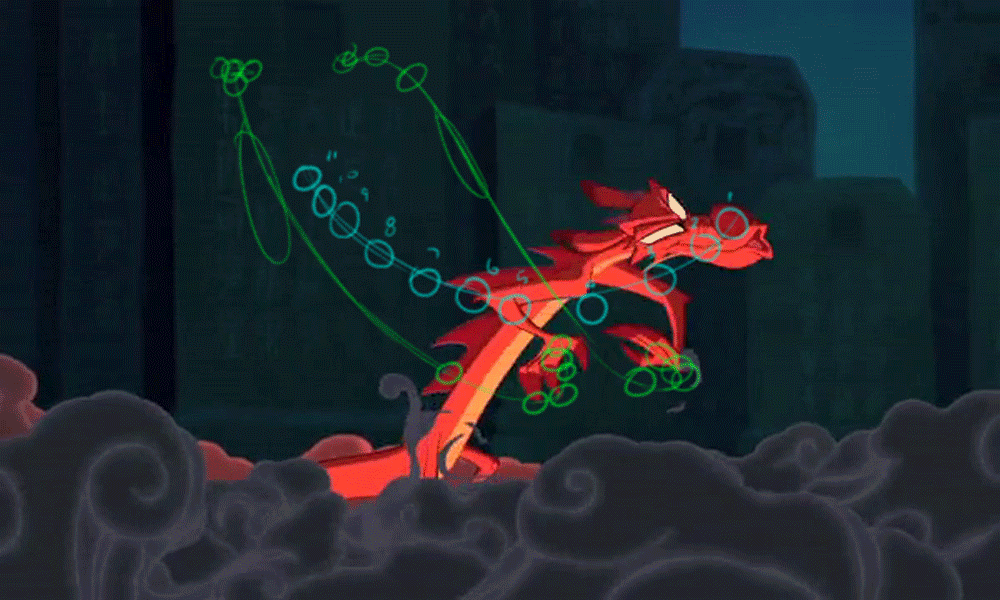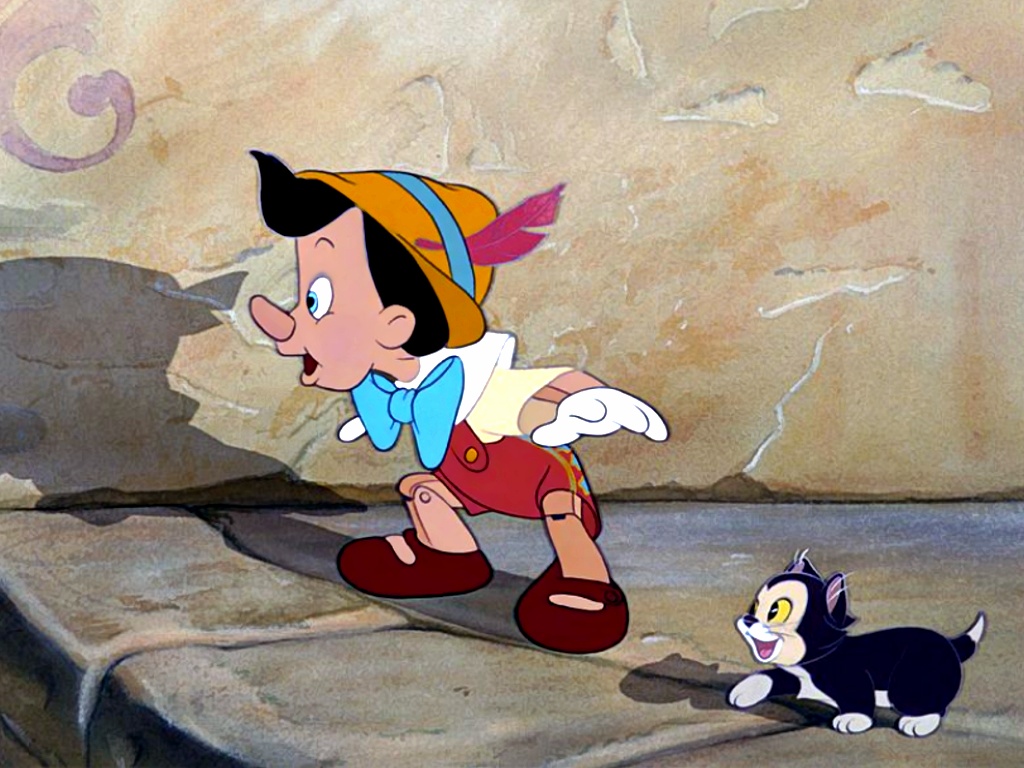In today’s lesson we learned about the 12 principles, stages of animation. This is Disney’s Animators Frank Thomas and Ollie Johnston guide to how objects and characters should behave when they are animated. I have added some examples where they are used in animation
1: Squash & Stretch, this is to give your object for example, the illusion of gravity and flexibility. A ball that bounces stretches when it is thrown but squishes if it hits a hard surface. Something that is lighter in weight will have more squash and stretch to something that is heavier. When you are animating an object it is important to keep the volume the same so stretching makes it thinner and squashing makes it wider. If you change the shape of someone’s head by flattening it, then the features on the face eyes mouth etc. will also flatten and change shape. If you stretch the head then the features will become elongated.
Here are some examples where this effect is used in cartoons, this effect makes the image have more meaning and interest.
2: Anticipation, this prepares a viewer for an action, for example a punch or a jump. The character should squat bend his/her knees before pushing their legs up into a jump. It is important to consider how the body moves before an action takes place as it could end up looking stiff and wooden, robotic and not realistic to the viewer. Weight should be taken into consideration is it light or heavy items that are lighter will move a lot faster than heavier items. Anticipation can also be used to direct the audience attention to something else, a character looking off screen with a surprised or shocked look can let the audience know that something is about to happen. This can be seen a lot in cartoons like Tom & Jerry and Donald Duck where they want to captivate the audience attention preparing them for something to happen, it makes the viewer excited to see whats going to happen as they are prepared for it. When you look at Donald Duck and Bugs Bunny in the images below you can see that they are getting ready to run and Tom from Tom & Jerry is getting ready to hit Jerry with the hammer by taking a big swing with the hammer first, Jerry is also showing a pose that he is ready to run.



3: Staging, this is to make the object noticeable presented well so it stands out. This can be achieved by the placement of a character in the frame, the use of light and shadow, and the angle and position of the camera. Small animated elements can be used to direct the viewer’s attention to an object or to show that something is moving. A car could have small trails behind it to show that it is driving fast. An example used in the film Ratatouille is when Remy is hidden amongst bottles of spices and would be lost if the other elements in the frame were not guiding the viewer to him, see photo below. Emile’s face, ears, nose and neck all point to Remy, the lines of the cookbook and shelf and the spice bottles all point to what is important in the frame. In my opinion this is important as it makes things stand out for the audience to see better. Also, in the second image Remy and his cheese are the most important part of the shot so they are at the front of the frame and in focus the building in the background does not stand out too much as it is slightly out of focus.
4: Straight Ahead / Pose to Pose, there are two ways of drawing animation. Straight ahead is animating frames one after the other this will make the animation flow better and look more natural and realistic, though it can be less planned and surprising as you don’t know where you are at any one time. Pose to Pose is when you animate the key events or first frame and last frame and then fill in between the gaps, poses were needed. This gives you more control over the action you can see if your character will be in the beginning scene and end scene instead of hoping you get the timing right. You can also see any mistakes and correct them easily.
These can be used together in many ways and the results will be varied.
5: Follow Through/ Overlapping, this is when different parts of objects stop moving at different times. This is important to consider in animation so that it looks realistic. Follow through, when different parts of one object stop moving at different rates, a bowl of jelly dragged along a table the jelly will keep on moving after the action. Overlapping, multiple objects moving at different rates. A ball with a feather attached bouncing along, the ball will come to a slow stop but the feather will still move a little as it is lighter than the ball.
Here is an example of Follow Through & Overlapping you can see how different objects in the animation move at different rates
6: Slow In and Slow Out, the speed of movement at the start and end is very important, a car will not suddenly drive at 60 miles an hour it will start off slowly and then gradually get to 60 it will then ease off slowly to get to a standstill. More frames are drawn at the beginning and end of a moving animation to give the appearance of acceleration. At the start we speed up and at the end we slow down.
Here is an example of slow in and slow out where Pooh Bear is blowing away a butterfly

7: Arc, all actions in life have a slight circular motion. If you turn your head or put out your arm it does not thrust forwards or go straight in and out it moves with a slight curve to it. If we take two poses, we cannot simply take the midpoint as this would look stiff and unrealistic, we must fill in the in-between points to make an arc. In VFX this principle is especially important and the most used due to it allowing the animation to look life like and pleasing to the audience eyes. A smooth arc is more pleasing than a rigid one. An example of an arc would be a bullet travelling and dropping as this happens it creates an arc. In my opinion it is important to try and take this principle into consideration to make things look realistic and not wooden and static.
Here is an example of arc used in animation the green line shows the arc shape


8: Secondary Action, this is an action that is additional to a primary action. It supports the primary action and should not dominate the first action. It can add dimension and emotion. Imagine a scene of two characters talking to each other and one of them scratches his head this would be the secondary action. In animation this is particularly important because it adds realism and life to it. An example would be a man walking swinging his arms in tune to music or scratching his head. In my opinion this is an important principle as it makes the animation more life like we can relate to things better.
Here you can see Pinocchio with his main emotion of staring in shock is assisted by the secondary actions of his arms being raised and the expressions of both himself and Figaro the cat.

9: Timing, this is important as it gives the illusion that the action is abiding by the law of physics. Timing can be adjusted to make a scene look smoother and slower or faster and sharper. More frames are added to make a scene seem slower and less are added to make the action faster. It is important to keep the timing consistent, so it is smoother and not to confuse the audience. The weight of an item should also be considered that is being animated for example, a feather will not go crashing to the ground at high speed and a ball made of steal will not float around whilst falling. In looney toons shows (Wile e. Coyote), gravity timing is often used as a comedy aspect where it doesn’t work to the law. The character only falls when he notices that he is floating. This is a consistent theme in loony toons shows. The timing is consistent but is not realistic, Wile only falls when he looks down or is running and gets so close to the other side of the canyon and falls just before he reaches the other side. The character is never supposed to float or reach the other side. Sometimes they make the landscape fall instead of the object that is held up by it. Wile can be seen cutting the rope bridge from the cliffside, but instead of the bridge falling as it should, the cliffside falls instead, this is unrealistic, but it is all part of loony toons. My opinion is, this makes the cartoons funny and enjoyable to watch as you see a lot of the unexpected happen.
Here you can see Wile still running even though he is nolonger on land he should be falling in reality.
10: Exaggeration, is all about overstating something, making it seem larger, better, bigger than it normally is. This is often done by adding comic exaggeration making it more pleasing and dynamic to watch. Too much realism can make an animation look boring, just going over the acceptable boundary gives the best results. In VFX specific actions or movements are exaggerated to draw attention to them or to make the audience feel a certain way often being very subtle and more realistic. Whilst feature animation uses extreme exaggeration in a more stylistic and cartoony way. A good example is in Jurassic Park movies where the dinosaurs are exaggerated in order to scare and thrill the audience, but also must have some realism in it. So, the principle is used in certain areas and quantities to maintain the realism.
Here you can see enlarged eyes on a man they are totally exagerated and popping out of the sockets this is like showing surprise. Also you can see the huge dinasour as tall as the trees in the second image.
11: Solid Drawings, all elements should be drawn accurately, clear shapes, weight distributed equally, Poses should clearly express thoughts, intentions, condition, wishes and feelings of a character. Use perspective, guide lines, make sure nothing is warped and is to scale. Consistency is important, if the animation has wonky or a strange perspective then make sure it is the same throughout. This is an important principle in VFX to make sure the audience is engaged and not confused by what is happening. This is an important principle especially if your animation is to be realistic and not made for a comedy aspect.
Here you can see Scar from Lion King he is drawn with shading and weight in mind to give an illusion of three dimension he is very well drawn and looks good to the eye, you can tell from the drawings that he is not a kind character.
12: Appeal, making sure the design is purposeful, easy to see and understand, a personality that is easy to read, interesting and compelling to the audience. Making sure it is well executed and complete finished. There is no right or wrong way to draw or animate but there should be a lot of planning and development phases. Different animations will appeal to different age groups, animations aimed at young pre school children are colourful, bright, cheerful smiley and have a lot of rounded shapes eg. Thomas the Tank Engine. In VFX, appeal makes the character stand out so when applied with special effects it will generate interest in the character. In my opinion this is very important in animation especially when you have a target audience.
I have chosen Mickey Mouse as an example as he is pleasing to look at with his happy face and stance he looks very inviting, welcomimg and kind.
The principles of animation are often combined together in animation, for example, Anticipation, Exaggeration and arc. A boy prepares to jump by bending his knees (anticipation) he makes a huge (exaggeration) leap and jump causing an arc effect.
For my brief, I will consider using most of the 12 principles as many as I can. I will use timing to make sure that everything flows well in the animation and looks as realistic as I can make it, I don’t want to confuse the audience. I will look at staging and make sure my characters are positioned well in the frame. I will try and bring in anticipation perhaps when Zeph and Bartosz are about to fight and when they first meet. I will add follow through or overlapping too, perhaps a feather charm on Zeph’s shield will move differently to the shield. I’m not sure if I will be able to use Slow in and Slow Out as there are no high-speed chases or bicycles and cars in the animation. I will try and make my characters appeal to the audience, Zeph is kind and gentle in appearance signifying a good guy, whereas Bartosz, I have tried to make him look more villain like in appearance. I will try and add Secondary Actions to make the animation look more lifelike. I will try and draw my characters well as best as I can for Solid Drawings. I will probably not use exaggeration as it is not that type of animation. I will try and animate using the the arc principle where necessary. I will also consider Squash & Stretch when animating the characters especially, to make sure everything is proportionate. Finally, I will take Straight Ahead / Pose to Pose into consideration too, which would suit my animation best.
Below is what we did in groups:




















